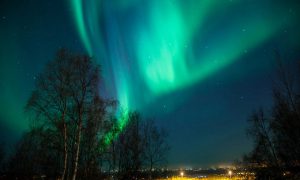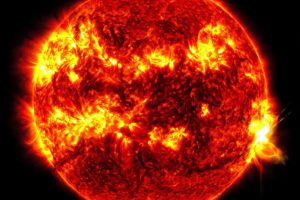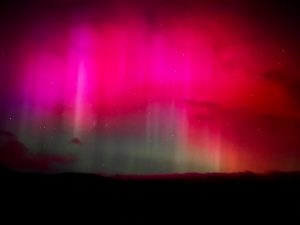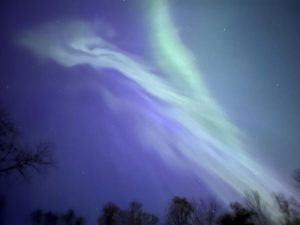Spectacular Northern Lights in May 2024

A little over a week ago, millions of Americans were amazed by the spectacular Northern Lights.
Streaks of jewel tones — purple and gorgeous green — flickered across the night sky, a display of undulating curtains normally seen in the polar region. And yet in much less remote areas, the Northern Lights, or the aurora borealis, appeared over suburban Chicago neighborhoods and even further south, above the Florida Keys and Puerto Rico.
To this or that degree, auroras were seen in all 50 states of the U.S. and across Europe and even Australia.

What are the Northern Lights?
The auroras are a natural light display in Earth’s sky that are famously best seen in high-latitude regions.
The aurora forms when the particles flowing from the sun get caught up in the Earth’s magnetic field. The particles interact with molecules of atmospheric gases to cause the famed glowing green and reddish colors of the aurora, according to NASA.
The composition and density of the atmosphere and the altitude of the collisions determine the colors of the lights, the University of Alaska, Fairbanks, said. “The aurora is most often seen as a striking green, but it also occasionally shows off other colors, ranging from red to pink or blue to purple,” the University said on its website.

Experts and the aurora chasers say that, most likely, this was only the beginning of the spectacles, as our sun is approaching the so-called “solar maximum”.
For those who caught the forecast in time last week and headed outside, the view was “epic,” aurora chaser Melissa F. Kaelin said some days after the event. “Last week’s dramatic display of the northern lights near Dexter, Michigan, rivals anything I’ve seen in 12 years of aurora chasing. The excitement still gives me chills,” she said.
“Solar max has definitely arrived,” astronomer Tony Phillips, of SpaceWeather.com, said. He added that the solar maximum could last for 2 or 3 years.
“The May 10th superstorm may have been just the first of several magnificent displays we experience between now and 2026,” he said.
So what’s causing all of the excitement? Why is the aurora so visible, all of a sudden?

Experts say it all has to do with our sun, solar cycles and the solar maximum. Here’s the details:
What are solar cycles? What is the solar maximum?
Solar cycles track the activity level of the sun, our nearest star. A cycle is traditionally measured by the rise and fall in the number of sunspots, but it also coincides with increases in solar flares, coronal mass ejections, radio emissions and other forms of space weather.
“The sun has an 11-year cycle where it goes through maximum and minimum,” Shannon Schmoll, the director of the Abrams Planetarium at Michigan State University says. “This results in the number of sunspots seen on the sun. Sunspots result from areas of the sun that have stronger magnetic fields.”
The number of sunspots on the sun’s surface changes on a fairly regular cycle, which scientists refer to as the sun’s 11-year solar cycle. Sunspot activity, and hence auroral activity, tends to peak every 11 years.
Sunspots produce solar flares and coronal mass ejections, which create the geomagnetic storms here on Earth that cause the aurora to appear.
“We are entering the peak of Solar Cycle 25,” Erica Grow Cei, a spokesperson for the National Weather Service, said last week. “This period of heightened activity is expected to last into the first half of 2025,” she added, meaning that additional chances for seeing the aurora will continue for at least the next year.
The image provided by NASA’s Solar Dynamics Observatory shows a solar flare, the bright flash of light on the right side of the sun, on Tuesday, May 14, 2024.

The sun produced its biggest flare in nearly a decade on May 14th just days after a severe solar storm pummeled Earth and created dazzling Northern Lights in places where auroras are not typically visible.
NASA’s Solar Dynamics Observatory captured the bright flash of the X-ray flare. It was the strongest since 2005, rated on the scale for these flares as X8.7.
Bryan Brasher at NOAA’s Space Weather Prediction Center in Boulder, Colorado said it may turn out to have been even stronger when scientists gather data from other sources.
It follows nearly a week of flares and mass ejections of coronal plasma that threatened to disrupt power and communications on Earth and in orbit. An ejection associated with May 14th flare appeared to have been directed away from our planet, although analysis is ongoing, Brasher noted.
When will the next northern lights show be? We won’t know until days – or hours – before.
Indeed, the aurora can be fickle to forecast. Unlike terrestrial weather, scientists who forecast space weather – which includes the aurora – must rely on observations of the sun, 93-million-miles-away, to make their predictions.

“There are so many uncertainties, it makes it difficult to predict,” Bill Murtagh, the program coordinator at the Space Weather Prediction Center, says. And as hard as it is to forecast weather here on Earth, “we are decades behind the forecast capabilities of our colleagues in meteorology,” he admits, referring to space weather.
Solar cycles tracked back to Colonial era
How are solar cycles measured? “The timing of the maximum and minimum of the solar cycle is predicted based largely on historical values and is verified through observations,” Cei says.
“The cycle is about 11 years in length, and in that regard it is very predictable. This solar cycle is known as #25 because it has been tracked for that long – back to the Colonial era,” she says.
“The chart for the current cycle shows it is running hotter than originally predicted,” Cei says.
Auroras also bring danger for electrical grid
But with the exciting news about the uptick in aurora sightings also comes the worrisome side of heightened solar activity: It can interfere with the electrical grid, degrade GPS signals, increase orbital drag on satellites, and pose radiation hazards to airline crews and astronauts, the Space Weather Prediction Center warned.

Stronger solar cycles produce more solar storms with greater intensity and therefore pose a larger hazard for these critical technologies and services, the prediction center said.
Minor disruptions from the last geomagnetic storm
The solar storm, which prompted NOAA to issue a watch alert for the first time in 19 years, caused some power grid irregularities and interfered with GPS signals – even farming equipment.
However, “based solely on the impacts that were reported to us, the disruptions were minor,” Cei said last week. “We may be able to provide specifics in the future, but not at this time, as many of our stakeholders have requested that we share this information in generalities.”
In general, she added that preparation pays off: “From what we’ve gathered so far (and this will be an ongoing process), it was a combination of infrastructure improvements over the past decade or so, plus excellent forecast information and decision support from the Space Weather Prediction Center that led to Americans experiencing a low-impact event.”
NOAA has detected another solar flare following sun-produced geomagnetic storm: ‘Not done yet.’
By Alex Arlander | ENC News

































